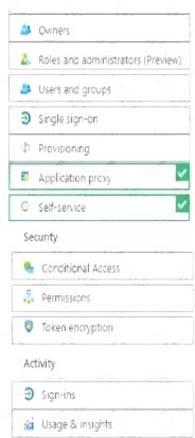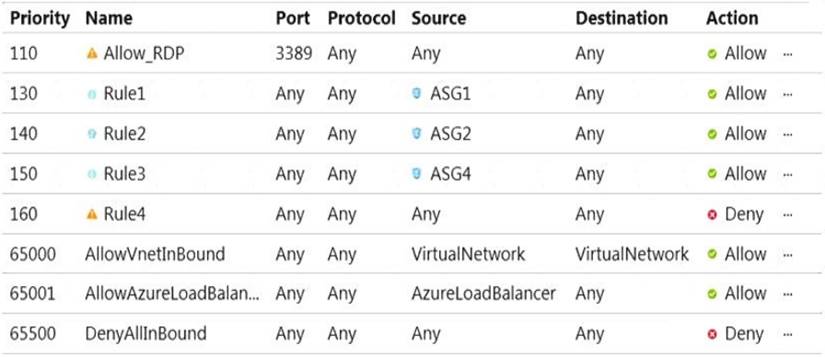- (Exam Topic 4)
You have an Azure subscription that contains the virtual machines shown in the following table.
VNET1, VNET2, and VNET3 are peered with each other. You perform the following actions:
* Create two application security groups named ASG1 and ASG2 in the West US region.
* Add the network interface of VM1 to ASG1.
Solution:
Does this meet the goal?
Correct Answer:
A
- (Exam Topic 4)
Your company plans to create separate subscriptions for each department. Each subscription will be associated to the same Azure Active Directory (Azure AD) tenant.
You need to configure each subscription to have the same role assignments. What should you use?
Correct Answer:
D
Just as a blueprint allows an engineer or an architect to sketch a project's design parameters, Azure Blueprints enables cloud architects and central information technology groups to define a repeatable set of
Azure resources that implements and adheres to an organization's standards, patterns, and requirements.
Blueprints are a declarative way to orchestrate the deployment of various resource templates and other artifacts such as: Role Assignments
Role Assignments  Policy Assignments
Policy Assignments Azure Resource Manager templates
Azure Resource Manager templates  Resource Groups
Resource Groups
Reference:
https://docs.microsoft.com/en-us/azure/governance/blueprints/overview
- (Exam Topic 4)
You company has an Azure subscription named Sub1. Sub1 contains an Azure web app named WebApp1 that uses Azure Application Insights. WebApp1 requires users to authenticate by using OAuth 2.0 client secrets.
Developers at the company plan to create a multi-step web test app that preforms synthetic transactions emulating user traffic to Web App1.
You need to ensure that web tests can run unattended. What should you do first?
Correct Answer:
B
https://docs.microsoft.com/en-us/azure/azure-monitor/app/availability-multistep
- (Exam Topic 4)
You have the Azure virtual networks shown in the following table.
You have the Azure virtual machines shown in the following table.
The firewalls on all the virtual machines allow ping traffic. NSG1 is configured as shown in the following exhibit. Inbound security rules
Outbound security rules
For each of the following statements, select Yes if the statement is true. Otherwise, select No.
NOTE: Each correct selection is worth one point.
Solution:
Box 1: Yes
VM1 and VM3 are on peered VNets. The firewall rules with a source of ASG1 and ASG2 allow ‘any’ traffic on ‘any’ protocol so pings are allowed between VM1 and VM3.
Box 2: No
VM2 and VM4 are on separate VNets and the VNets are not peered. Therefore, the pings would have to go over the Internet. VM4 does have a public IP and the firewall allows pings. However, for VM2 to be able to ping VM4, VM2 would also need a public IP address. In Azure, pings don’t go out through the default gateway as they would in a physical network. For an Azure VM to ping external IPs, the VM must have a public IP address assigned to it.
Box 3: Yes
VM3 has a public IP address and the firewall allows traffic on port 3389.
Does this meet the goal?
Correct Answer:
A
- (Exam Topic 4)
You are securing access to the resources in an Azure subscription.
A new company policy states that all the Azure virtual machines in the subscription must use managed disks. You need to prevent users from creating virtual machines that use unmanaged disks.
What should you use?
Correct Answer:
B